Meta Ads only work if Meta gets accurate data. But on Shopify, tracking is often broken — blocked by browsers, limited by checkout, or missing key events. That means lost conversions, poor optimization, and misleading ROAS.
This guide compares Shopify’s native Meta setup with Analyzify’s server-side solution, showing how hybrid tracking (Pixel + CAPI) helps you recover lost data and improve ad performance.
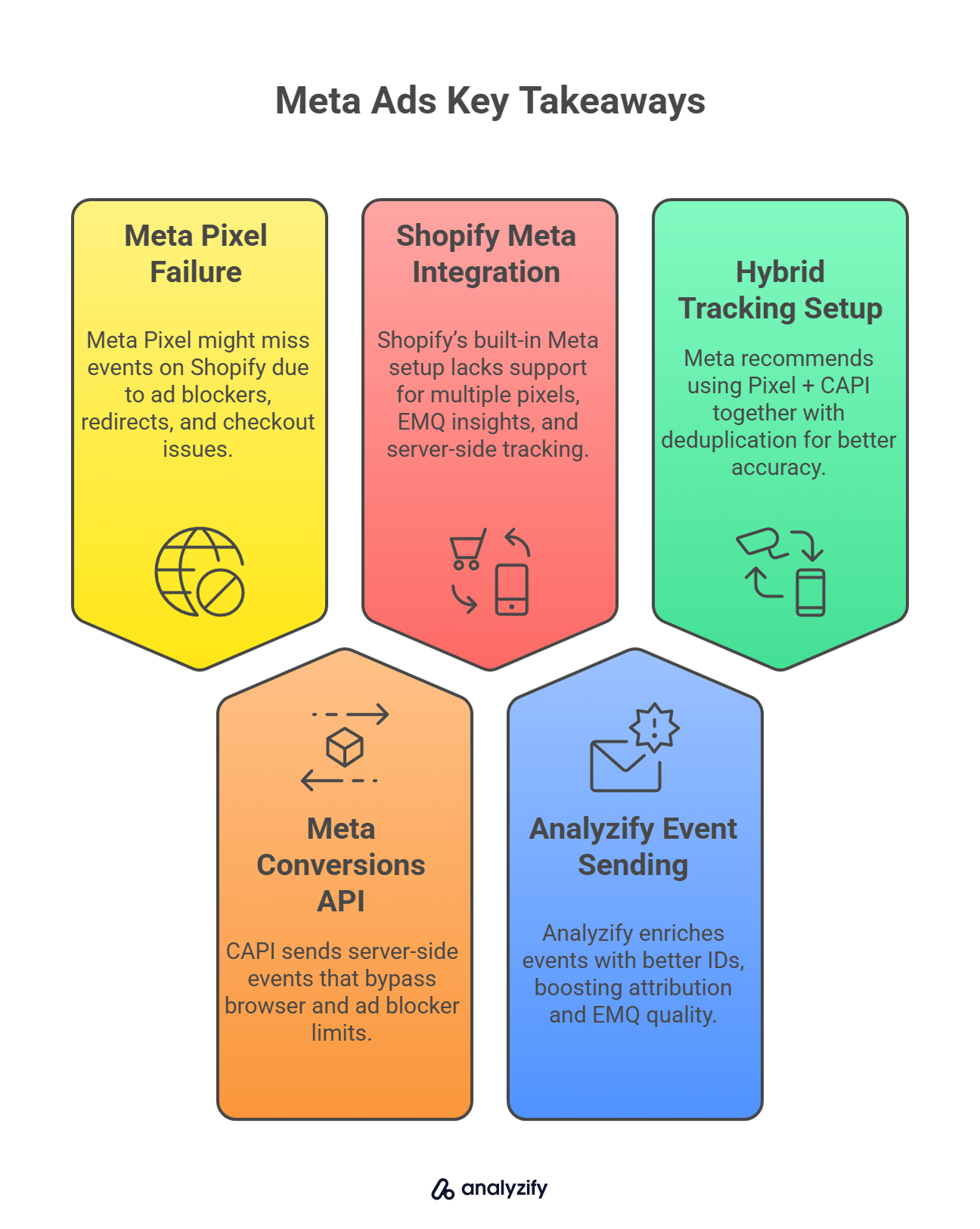
✅ 5 Key Takeaways You’ll Learn:
Meta Pixel alone often fails on Shopify due to ad blockers, redirect flows, and checkout restrictions.
Meta Conversions API (CAPI) delivers server-side events that bypass browser limitations.
Shopify’s native Meta integration lacks support for multiple pixels, EMQ visibility, and server-side tracking.
Analyzify sends enriched events with better customer identifiers, improving attribution and EMQ scores.
Meta recommends a hybrid tracking setup (Pixel + CAPI) with deduplication to ensure accuracy and consistency.
Why Meta (Facebook) Ads Might Misreport Conversions on Shopify
You launch a campaign. Clicks come in. Sales happen. But your Meta Ads Manager shows fewer conversions than you know actually occurred. Sound familiar?
It’s a known outcome of how tracking works on Shopify and how it often fails without warning.

Here are the biggest culprits:
Ad blockers and browser privacy features silently block Meta Pixel scripts from firing.
Shopify’s checkout limitations prevent consistent data capture during the final step.
External payment gateways like PayPal or Klarna break the conversion flow.
iOS restrictions limit cookie tracking, leading to missing session and user data.
Users skipping the thank_you page cause events to never trigger at all.
None of these issues alert you. You’ll just see fewer conversions and assume your ads underperformed, when in reality, Meta simply didn’t see the purchases.

This leads to two major problems:
Under-optimized campaigns: Meta can’t learn from events it doesn’t receive, so your ads don’t improve.
Misleading ROAS reports: You think you’re losing money when you’re actually just losing visibility.
For Shopify stores that rely only on the pixel or the native Facebook integration, they show up in the form of missing purchases, low Event Match Quality scores, and under-attributed campaigns.
 Improve Your Meta Tracking Accuracy
Improve Your Meta Tracking Accuracy 
Improve Your Meta Tracking Accuracy
Enhanced conversion tracking with Meta Conversion API for better ad performance and more accurate attribution.The Two Ways to Track Meta Ads on Shopify: Pixel vs. Conversion API
Meta offers two different tracking methods, and they serve different purposes:
Meta Pixel (client-side): Tracks user actions through the browser. It captures page views, clicks, add-to-carts, and purchases as long as the browser allows it.
Meta Conversions API (server-side): Sends events directly from your server to Meta, bypassing browser restrictions and ad blockers.
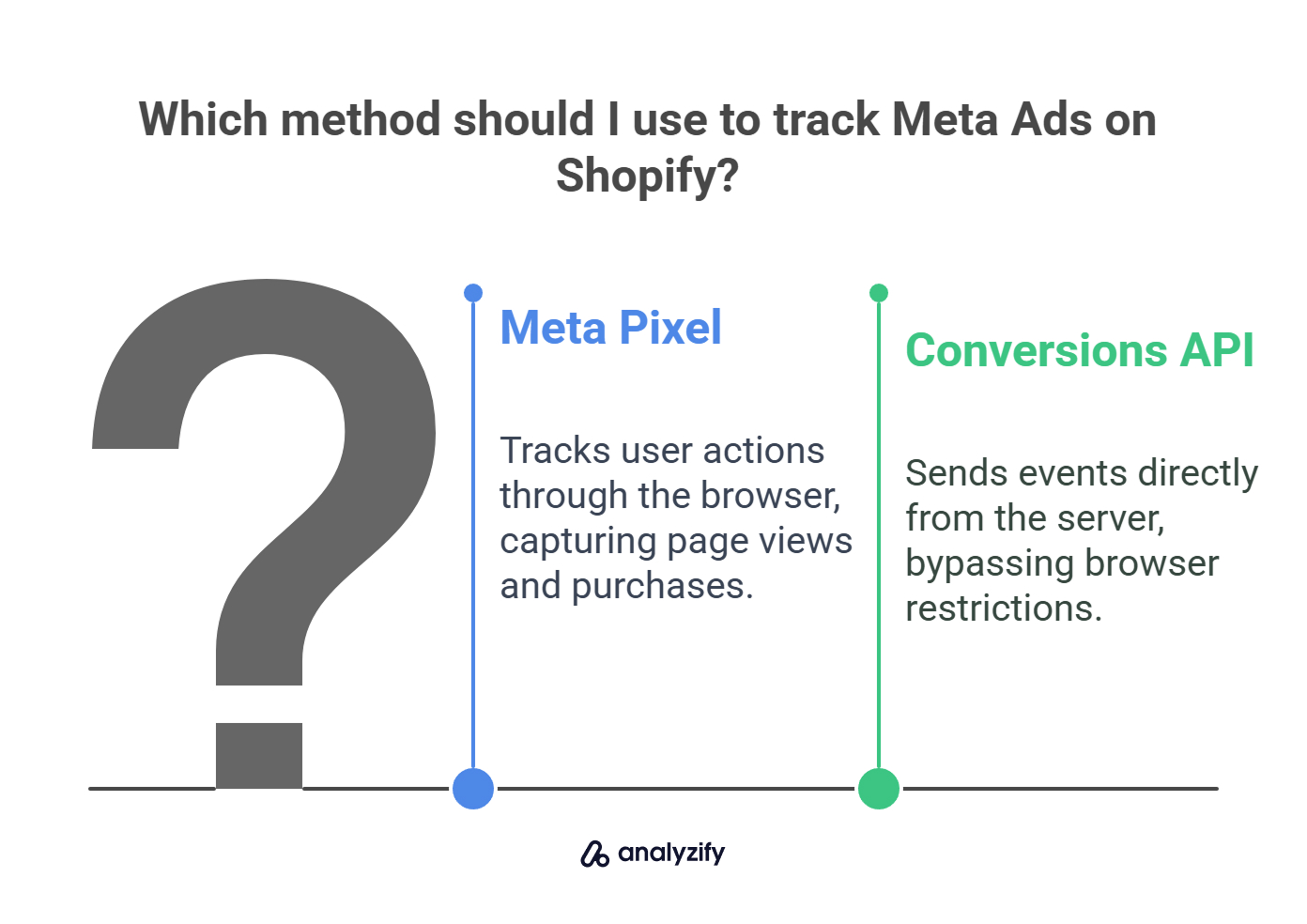
Each method has its limits. The Pixel can be blocked or skipped if the page doesn’t load fully. The Conversions API doesn’t have access to session-level data like UTMs or consent unless passed from the browser.
That’s why Meta recommends a hybrid setup:
Pixel provides real-time, session-level insights.
Meta CAPI ensures conversion data is delivered, even when the Pixel fails.
When both are used together with deduplication, Meta receives clean, complete data without double-counting events.
What the Native Shopify-Meta Integration Covers (And What It Misses)
Shopify’s native Facebook & Instagram Sales Channel offers basic Meta tracking. It’s quick to install and covers essential events like:
Page View
View Content
Add to Cart
Purchase
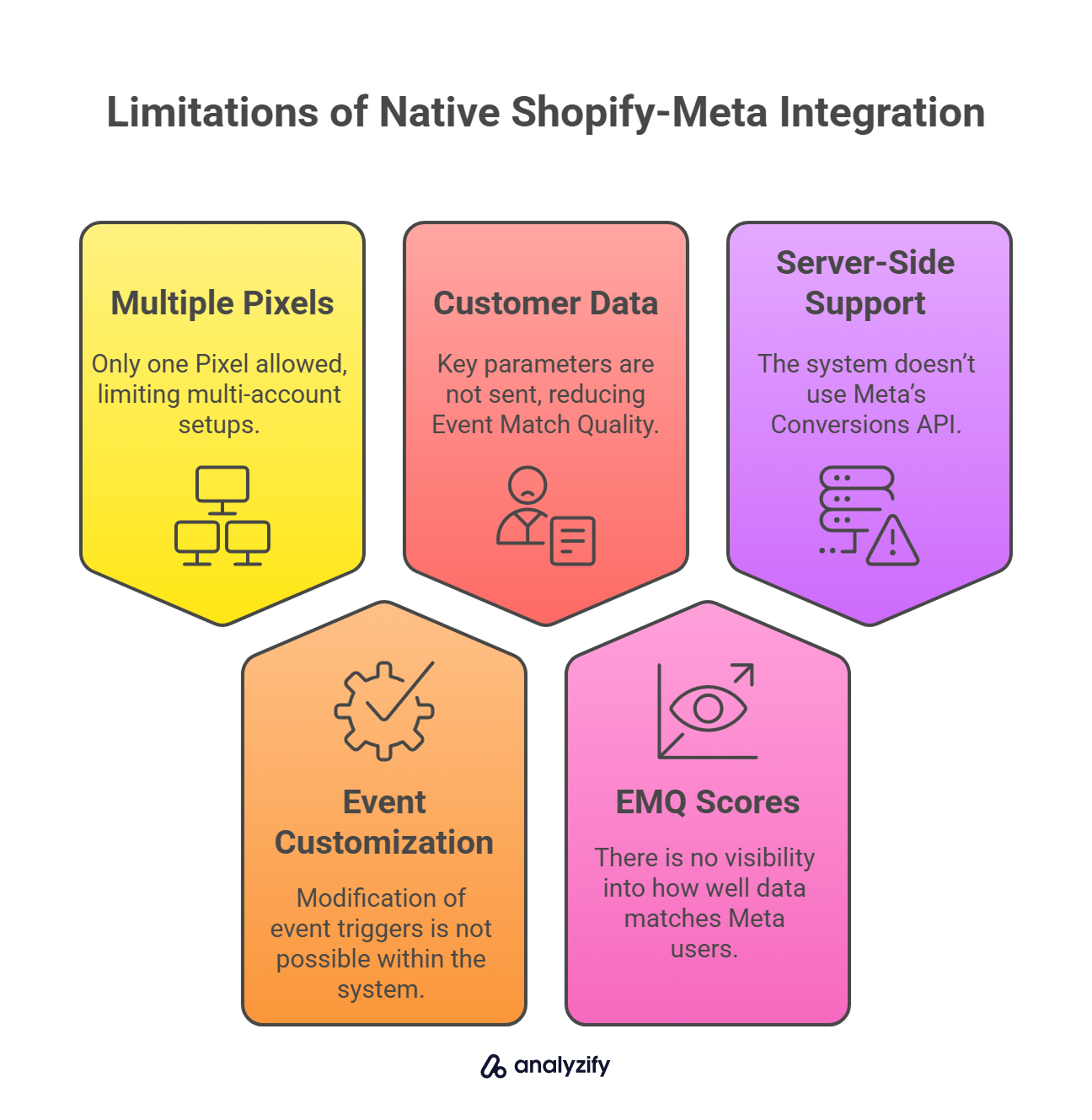
However, it comes with important limitations that affect both data quality and ad performance:
No support for multiple pixels: You’re limited to a single Meta Pixel, which makes it harder to manage multiple ad accounts or audiences.
No event customization: You can’t modify how or when events are triggered.
Limited customer data: Key parameters like ZIP code, city, and external ID aren’t sent — reducing your Event Match Quality (EMQ).
No visibility into EMQ scores: You don’t see how well your data matches Meta users.
No server-side support: It doesn’t use Meta’s Conversions API, so you lose events blocked by browsers or ad settings.
If you’re running ads casually, the native setup might be enough. But if performance matters, the gaps in data and control make a real difference.
Bonus: Learn more about how to set up Meta (Facebook) server-side tracking with the Conversions API (CAPI)
Optimize Meta Ads with Better Data Collection (Analyzify Approach)
Analyzify helps fill the gaps left by the native integration by combining client-side Pixel tracking with Meta’s Conversions API - exactly as Meta recommends.
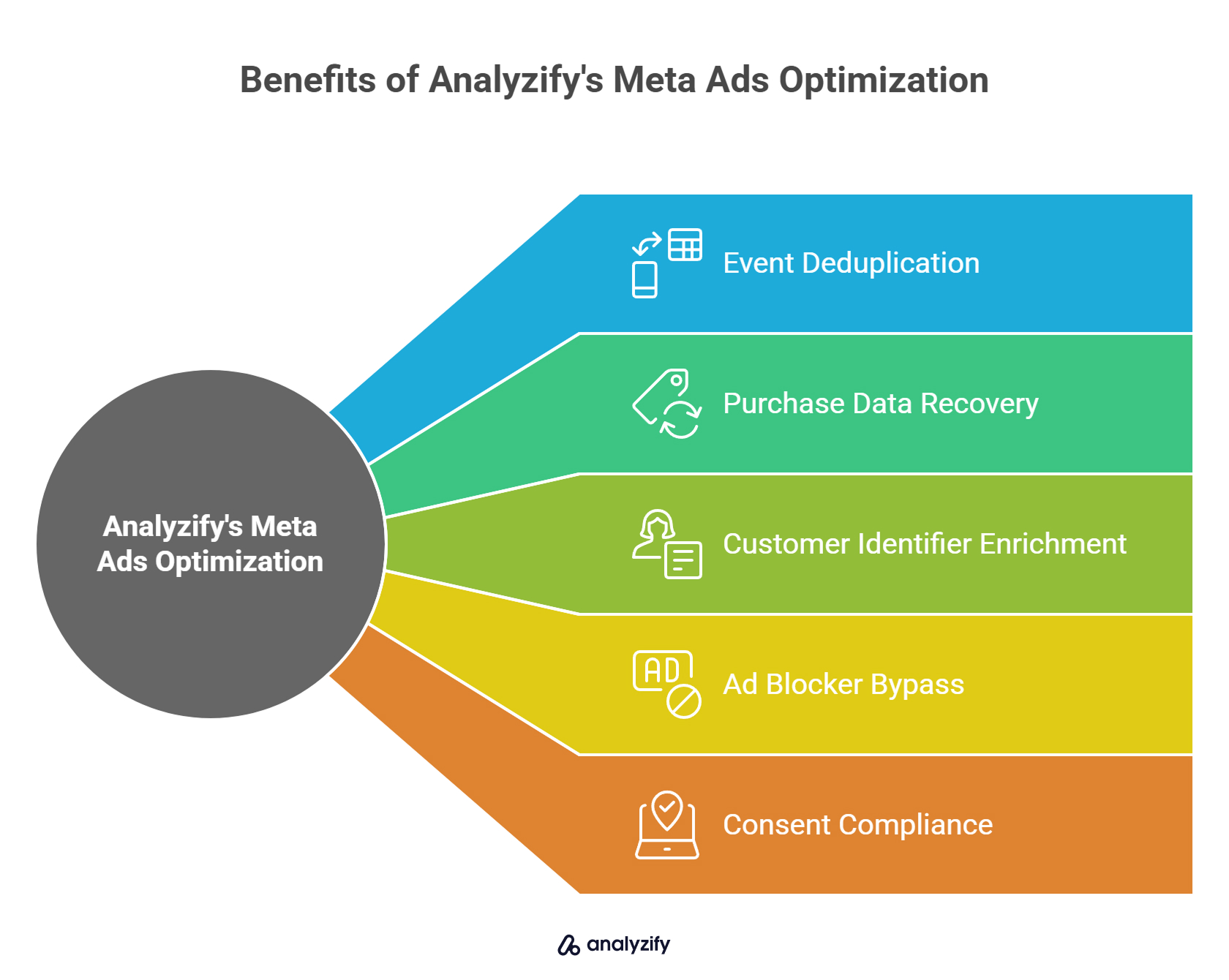
Here’s how this hybrid setup improves your Meta data:
Events are captured twice but only counted once. The Pixel and CAPI work together with event deduplication, so Meta receives complete data without inflating reports.
Purchase data is recovered even if the Pixel fails. If a thank_you page doesn’t load or the user pays through PayPal, the server still sends the event.
Events are enriched with customer identifiers. Analyzify includes email, phone, IP address, ZIP code, and external IDs, boosting your Event Match Quality.
Ad blockers are no longer a barrier. Since the server handles delivery, key events like purchases aren’t lost to browser issues.
Consent is handled properly. Tracking respects Shopify’s privacy tools and stays compliant with GDPR.
Instead of relying on the browser to do all the work, Analyzify turns your Shopify backend into a more reliable data source, giving Meta what it needs to optimize your campaigns.
 Built for Shopify - No Dev Work Required - Fast Setup
Built for Shopify - No Dev Work Required - Fast Setup 
Start Tracking Shopify Orders Accurately!
Let Analyzify's enhanced server-side tracking provide you with more accurate & reliable attribution data - setup in 10-15 minutes.Analyzify vs. Native Meta Integration: Side-by-Side
Shopify’s native Meta integration covers the basics, but it lacks visibility, flexibility, and depth. Analyzify, on the other hand, is built specifically to solve the problems that affect Meta tracking on Shopify, particularly those related to conversion accuracy and data quality.
Here’s a clearer look at how the two setups differ in practice:
| Feature | Shopify Native Meta Integration | Analyzify |
|---|
| 1. Tracking Method & Reliability | Uses only the Meta Pixel (client-side). Tracking can break due to browser restrictions, ad blockers, or privacy settings. | Uses both Pixel and Conversions API (hybrid tracking). If one method fails, the other still captures the event. |
|---|
| 2. Control & Customization | Allows only one pixel per store. No option to customize events, use GTM, or tailor tracking to store structure. | Supports multiple pixels, GTM, and fully customizable event parameters based on your catalog and campaign needs. |
|---|
| 3. Event Match Quality (EMQ) | Sends only basic customer data, which lowers EMQ and weakens attribution. | Sends enriched data like city, ZIP, hashed email, phone number, and external ID to boost match quality. |
|---|
| 4. Event Deduplication | No event ID handling. Can result in duplicate conversion events when using Pixel and CAPI together. | Assigns consistent event IDs to prevent duplicates and ensure accurate reporting. |
|---|
| 5. Debugging, Visibility & Support | No access to event logs, EMQ scores, or payloads. No dedicated support for setup or troubleshooting. | Full access to validation tools, tracking logs, and expert support for implementation, QA, and fixes. |
|---|
![]()
1) Tracking Method and Reliability
The native integration relies solely on the Meta Pixel, which is client-side. This means it depends on the browser working perfectly but browser limitations, ad blockers, and privacy settings often interfere. Analyzify uses both the Pixel and the Conversions API (CAPI), so the same event is sent both client-side and server-side. If one fails, the other still delivers the data.
2) Control and Customization
Shopify’s native app offers no ability to customize event parameters, add multiple pixels, or adjust tracking based on store structure. Analyzify gives you full flexibility: multiple pixels, GTM compatibility, and enriched event data tailored to your catalog and campaigns. This control is essential if you’re managing multiple ad accounts or custom funnels.
3) Event Match Quality (EMQ)
The native setup sends limited customer data, often just the basics. This results in lower EMQ scores, which reduce Meta’s ability to match conversions to users. Analyzify includes additional fields like ZIP code, city, external ID, phone number, and hashed email. These increase the match rate and directly improve how Meta attributes and optimizes your ads.
4) Event Deduplication
Running both Pixel and CAPI creates a risk of double-counting events unless properly configured. Shopify’s native app doesn’t offer deduplication. Analyzify assigns consistent event IDs and ensures Meta counts each action once, cleanly. This is a critical part of hybrid tracking and affects attribution accuracy.
5) Debugging, Visibility, and Support
If something breaks in the native app, you’re left without detailed logs or support. There’s no way to inspect EMQ scores or event payloads. Analyzify provides full validation, access to your tracking status, and a support team that handles implementation, testing, and troubleshooting.
In short, the native Shopify-Meta integration is fine for basic setups. But for stores running performance-focused campaigns ,or any store serious about attribution accuracy, Analyzify’s hybrid system provides a deeper, more reliable solution.
 Built for Shopify - No Dev Work Required - Fast Setup
Built for Shopify - No Dev Work Required - Fast Setup 
Missing Conversions in GA4 or Meta Ads?
Standart browsing tracking misses conversions - Analyzify adds Server-side tracking for accurate GA4 & Meta reports.Why Event Match Quality (EMQ) Matters for ROAS
Meta’s algorithm looks at how confidently it can connect that purchase to a real user. That confidence is measured through Event Match Quality (EMQ).
Each event you send to Meta (like a purchase or add-to-cart) is scored based on how many usable identifiers are included. These might be:
Hashed email address
Phone number
ZIP code and city
External ID (like Shopify customer ID)
Browser IDs (like _fbp and _fbc)
The higher the quality and matchability of this data, the more likely Meta will attribute the event correctly to a campaign or audience.
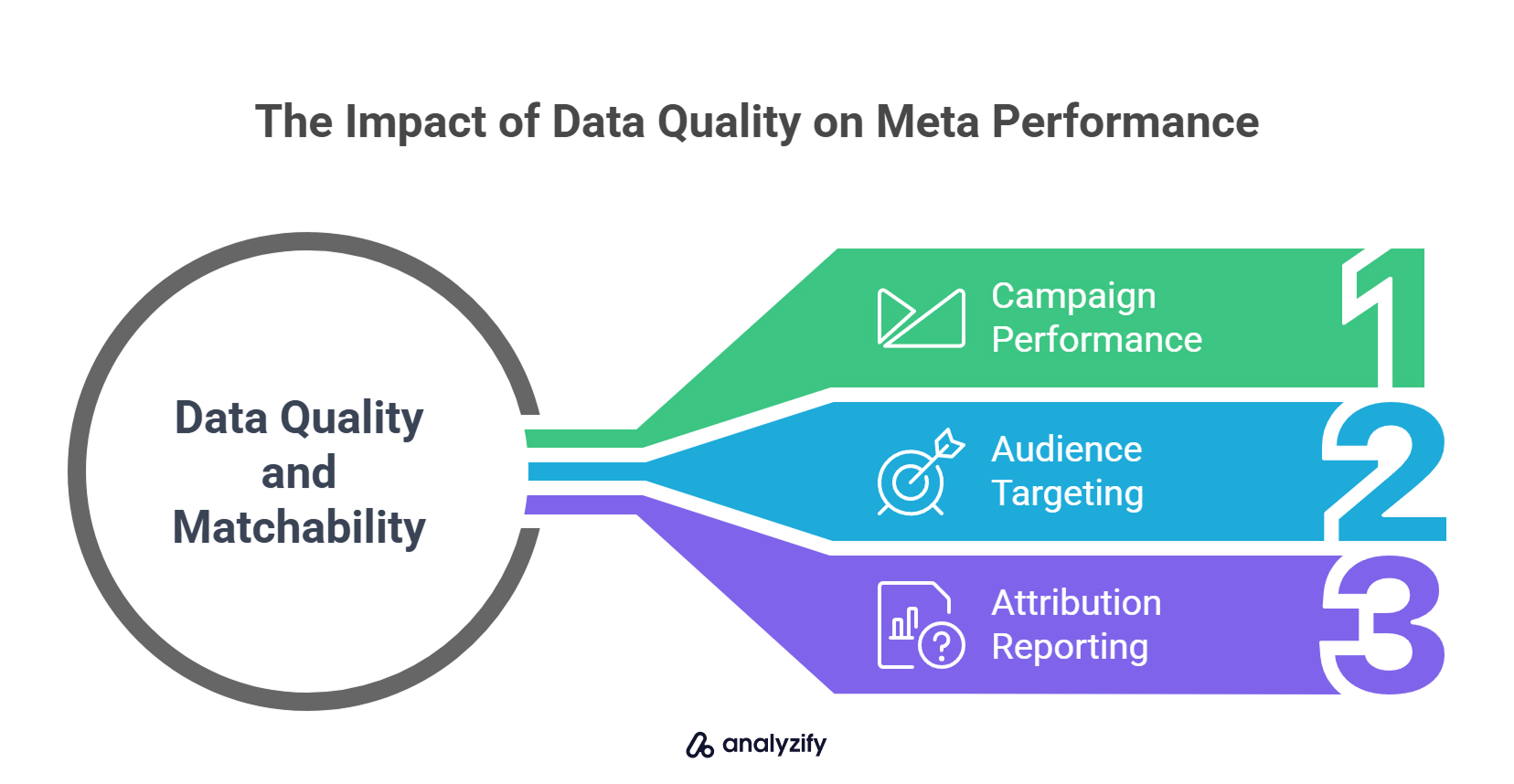
Here’s why that matters:
Campaign performance depends on match quality. If Meta doesn’t know who converted, it can’t optimize properly. The ad delivery algorithm will have weaker feedback and slower learning.
Lookalike and retargeting audiences get diluted. When fewer users are matched, Meta has less information to build high-intent segments. This reduces targeting precision.
Attribution reporting becomes unreliable. With low EMQ, conversions may go unattributed or misattributed. You’ll see lower ROAS not because the campaign failed, but because Meta couldn’t connect the dots.
Analyzify improves EMQ by sending server-side events enriched with all supported identifiers, captured during checkout or from logged-in sessions. Combined with the Pixel, this creates a more complete profile and leads to stronger match rates.
Higher EMQ is what makes Meta ads work the way they should.
Do You Really Need Server-Side Tracking for Meta Ads?
Some merchants still assume server-side tracking is optional — or only relevant for large brands with big ad budgets. In reality, that assumption no longer holds true, especially on Shopify.
![]()
Here’s why:
Pixel-only setups no longer provide reliable tracking. With ad blockers, Safari’s privacy features, and iOS restrictions, even a properly installed Meta Pixel often fails to fire. You may never know an event was missed, but your performance data will reflect it.
Shopify’s checkout creates structural blind spots. The native flow often skips the thank_you page or blocks custom scripts during payment. That’s when server-side delivery becomes the only way to ensure conversions are registered.
Meta now expects a hybrid setup. According to Meta’s own documentation, the recommended best practice is to use both the Pixel and the Conversions API together, not as alternatives, but as complementary methods. Without both, you’re simply not sending Meta the data it needs.
Event Match Quality and deduplication only work in hybrid setups. If you’re not using server-side tracking, you can’t activate EMQ scores properly, and you lose out on attribution accuracy, even if the conversions happen.
That’s why Analyzify’s approach is about building a tracking system that actually works by combining browser signals with server-side delivery and layering in privacy-safe consent handling.
If you’re spending any meaningful budget on Meta Ads, the cost of poor tracking outweighs the effort of setting it up correctly.
 Built for Shopify - No Dev Work Required - Fast Setup
Built for Shopify - No Dev Work Required - Fast Setup 
Standart Tracking Methods Aren't Enough for Shopify
Let Analyzify combine client-side and server-side tracking. So you capture every important event, even when browser script fail.Final Thoughts: Better Tracking Means Smarter Ads
If Meta can’t see your conversions clearly, it can’t optimize your campaigns, report true ROAS, or build reliable audiences.
Shopify’s native Meta integration may be enough for a basic presence, but it wasn’t designed to handle today’s tracking challenges. Server-side tracking with Meta CAPI fills the gaps, and when combined with Pixel tracking in a hybrid setup, it becomes the most effective way to collect, match, and deliver your data.
Analyzify simplifies that process for Shopify merchants, combining flexibility, accurate event delivery, and full EMQ optimization without requiring you to manage technical infrastructure.
Ready to see how your Meta tracking could improve?
Start with a quick implementation check or explore the [Analyzify vs. Native Meta comparison] to understand what you might be missing.
 Built for Shopify - No Dev Work Required - Fast Setup
Built for Shopify - No Dev Work Required - Fast Setup 
Start Tracking Shopify Orders Accurately!
Let Analyzify's enhanced server-side tracking provide you with more accurate & reliable attribution data - setup in 10-15 minutes.
































